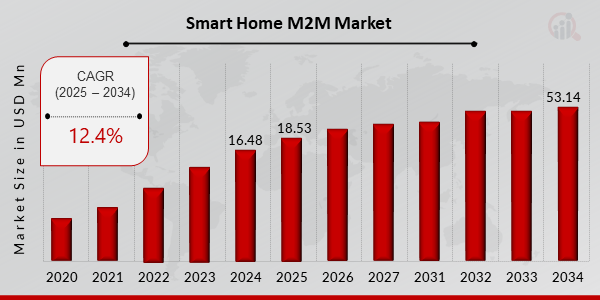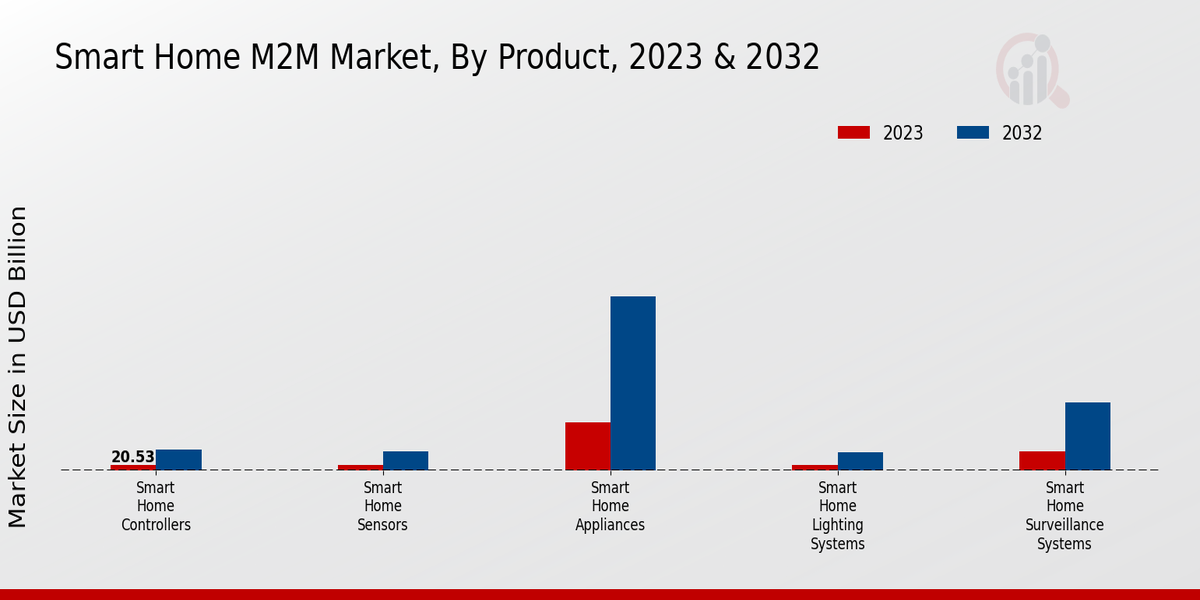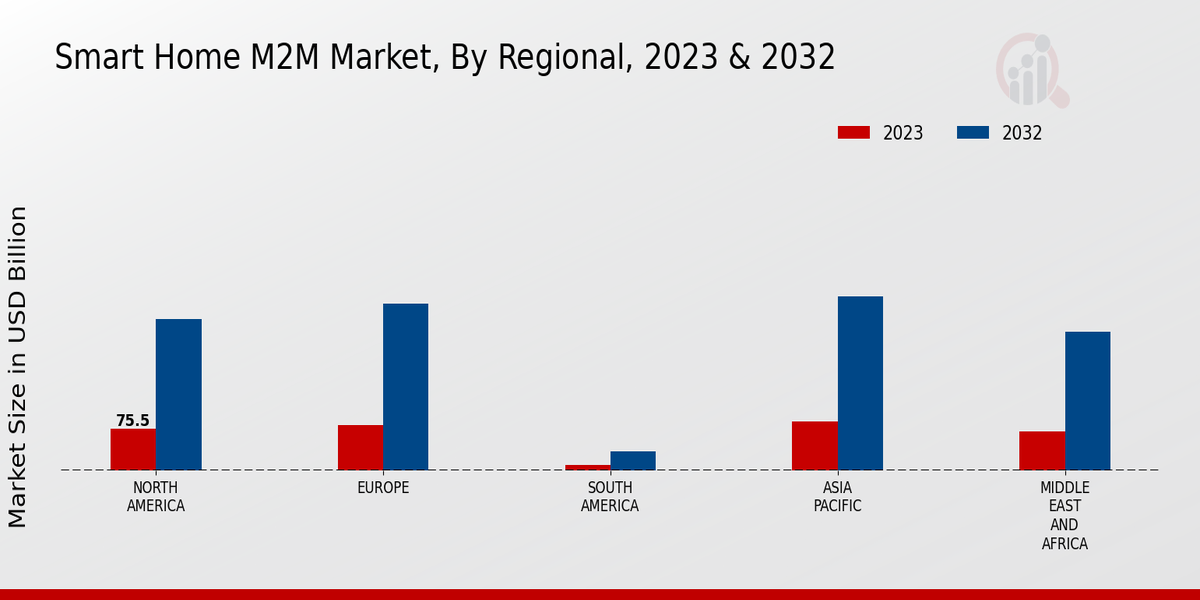Global Smart Home M2M Market Overview
Smart Home M2M Market Size was estimated at 16.48 (USD Million) in 2024. The Smart Home M2M Market Industry is expected to grow from 18.53 (USD Million) in 2025 to 53.14 (USD Million) by 2034. The Smart Home M2M Market CAGR (growth rate) is expected to be around 12.4% during the forecast period (2025 - 2034).
Key Smart Home M2M Market Trends Highlighted
The integration of advanced technologies into residential settings is driving the expansion of the smart home M2M market. Consumers are increasingly adopting smart home devices and appliances to enhance convenience, security, and energy efficiency. The growing demand for remote home monitoring, automated control, and personalized experiences is fueling the adoption of M2M solutions in the smart home space.
Key market drivers include the proliferation of IoT devices, advancements in wireless connectivity, and the increasing affordability of smart home technologies. The growth of cloud computing and data analytics platforms further enables the collection, analysis, and utilization of data generated by smart home devices, enhancing their functionality and user experience.
Recent trends indicate a shift towards interoperable and voice-controlled smart home devices. Consumers are embracing seamless connectivity and compatibility among different devices and platforms. Additionally, the integration of artificial intelligence (AI) and machine learning (ML) technologies is empowering smart home systems with improved personalization, automation, and decision-making capabilities.
These advancements are expected to continue shaping the future of the smart home M2M market, offering new opportunities for innovation and growth.

Source: Primary Research, Secondary Research, MRFR Database and Analyst Review
Smart Home M2M Market Drivers
Rising Demand for Smart Home Devices
The increasing popularity of smart home devices is a major driver of growth in the Smart Home M2M Market Industry. Consumers are increasingly adopting smart home devices such as smart speakers, smart thermostats, and smart lighting systems to enhance their convenience, security, and energy efficiency. The growing adoption of smart home devices is expected to continue to drive demand for M2M connectivity solutions, as these devices require seamless and reliable connectivity to function effectively.
Additionally, the growing popularity of voice-controlled devices such as Amazon Echo and Google Home is also contributing to the demand for M2M connectivity, as these devices rely on M2M communication to interact with other smart home devices and services. The rising demand for smart home devices is expected to remain a key driver of growth in the Smart Home M2M Market Industry over the forecast period.
Advancements in IoT Technology
Advancements in IoT technology are also driving the growth of the Smart Home M2M Market Industry. The development of new IoT technologies, such as low-power wide-area networks (LPWANs) and mesh networks, is enabling the deployment of smart home devices in a wider range of environments. LPWANs, such as LoRa and Sigfox, provide long-range connectivity with low power consumption, making them ideal for connecting smart home devices that are located in remote or difficult-to-reach areas. Mesh networks, on the other hand, allow smart home devices to communicate with each other directly, creating a more resilient and reliable network.
These advancements in IoT technology are expected to continue to drive the growth of the Smart Home M2M Market Industry as they enable the deployment of more sophisticated and interconnected smart home systems.
Growing Adoption of Cloud-Based Services
The growing adoption of cloud-based services is another key driver of growth in the Smart Home M2M Market Industry. Cloud-based services provide a number of benefits for smart home users, including remote access to their devices, data storage and analysis, and the ability to control their smart home systems from anywhere with an internet connection. The growing popularity of cloud-based services is expected to continue to drive demand for M2M connectivity solutions, as these services require reliable and secure connectivity to function effectively.
Additionally, the development of new cloud-based services, such as artificial intelligence (AI)-powered home automation systems, is also expected to contribute to the growth of the Smart Home M2M Market Industry.
Smart Home M2M Market Segment Insights
Smart Home M2M Market Product Insights
The Smart Home M2M Market is segmented by product into smart home controllers, smart home sensors, smart home appliances, smart home lighting systems, and smart home surveillance systems. Smart home controllers are the brains of the smart home, connecting different devices and systems to enable seamless control and automation. Smart home sensors monitor various aspects of the home environment, such as temperature, motion, and air quality, providing data for automated actions and notifications. Smart home appliances include smart TVs, refrigerators, ovens, and washing machines that offer remote control, energy efficiency, and personalized experiences.
Smart home lighting systems enable remote control and automation of lighting, creating customized ambiance and enhancing convenience. Smart home surveillance systems provide security and peace of mind through remote monitoring, motion detection, and alerts. The smart home controllers segment held the largest market share in 2023 and is projected to maintain its dominance throughout the forecast period. The increasing demand for centralized control and automation, coupled with the proliferation of smart home devices, is driving the growth of this segment.
Smart home sensors are also expected to witness significant growth due to their crucial role in data collection and automated actions. The growing adoption of IoT-enabled devices and the need for enhanced home security are key factors contributing to the growth of the smart home sensors segment. Smart home appliances are projected to have a promising growth trajectory, driven by the increasing popularity of connected and energy-efficient appliances. The growing consumer preference for convenience and personalized experiences is expected to fuel the demand for smart home appliances.
Smart home lighting systems are also gaining traction due to their ability to enhance home aesthetics, provide energy savings, and enable remote control. The growing adoption of smart lighting solutions in both residential and commercial settings is expected to drive the growth of this segment. Smart home surveillance systems are expected to witness steady growth as consumers become more concerned about home security and seek remote monitoring capabilities. The integration of advanced technologies, such as artificial intelligence and facial recognition, is expected to further enhance the effectiveness and demand for smart home surveillance systems.

Source: Primary Research, Secondary Research, MRFR Database and Analyst Review
Smart Home M2M Market Connectivity Insights
Connectivity Segment Overview and Insights The connectivity segment plays a pivotal role in the Smart Home M2M Market, enabling communication and data exchange among smart devices. Wi-Fi dominates the segment, holding a market share of around 60% in 2023 due to its widespread availability, high bandwidth, and low latency. Bluetooth accounts for a significant portion, particularly in short-range applications such as lighting control and audio streaming. Zigbee and Z-Wave are gaining traction in smart home automation due to their mesh networking capabilities and energy efficiency.
Cellular connectivity, such as LTE and 5G, is increasingly used for remote monitoring and control of devices in applications like security and energy management.
Smart Home M2M Market Application Insights
The Smart Home M2M Market segmentation by Application includes Home Security, Home Control, Energy Management, Entertainment, and Health and Wellness. Among these, Home Security held the largest revenue share in 2023 due to growing security concerns and the increasing adoption of smart home devices for security purposes. Home Control is another significant segment, driven by the rising demand for convenient and automated home management solutions. Energy Management is expected to witness substantial growth in the coming years as consumers become more conscious of energy efficiency and seek ways to reduce their energy consumption.
Entertainment applications account for a sizable portion of the market, driven by the growing popularity of streaming services and smart TVs. Health and Wellness is an emerging segment, with increasing adoption of smart home devices for health monitoring and fitness tracking.
Smart Home M2M Market Type of Device Insights
The Smart Home M2M Market is segmented by Type of Device into Standalone Devices, Hub-Based Systems, and Cloud-Based Systems. Among these segments, Standalone Devices held the largest market share in 2023. However, Hub-Based Systems are projected to witness the highest CAGR during the forecast period. Standalone Devices are devices that can connect to the internet and function independently without the need for a central hub. These devices include smart speakers, smart plugs, and smart light bulbs. Hub-based systems consist of a central hub that connects to various smart devices and controls their functionality.
Cloud-based systems are devices that store and process data in the cloud, allowing users to access and control their smart devices remotely. The increasing adoption of smart home devices is driving the growth of the Smart Home M2M Market. The growing popularity of voice assistants, the increasing demand for home security, and the rising awareness of energy efficiency are some of the factors contributing to the market growth.
Smart Home M2M Market Regional Insights
The Smart Home M2M Market is segmented by region into North America, Europe, APAC, South America, and MEA. North America is expected to hold the largest market share in 2023, owing to the high adoption of smart home devices and the presence of major players in the region. Europe is expected to follow North America, driven by the growing demand for smart home solutions in countries such as Germany, the UK, and France. APAC is expected to witness significant growth in the coming years due to the rising disposable income and increasing urbanization in the region.
South America and MEA are expected to have a relatively smaller market share, but they are expected to grow at a steady pace over the forecast period.

Source: Primary Research, Secondary Research, MRFR Database and Analyst Review
Smart Home M2M Market Key Players And Competitive Insights:
Major players in the Smart Home M2M Market industry are continuously developing and launching new products and services to stay competitive. They are also investing in research and development to create innovative solutions that meet the evolving needs of consumers. Leading Smart Home M2M Market players are also focusing on strategic partnerships and acquisitions to expand their market reach and product portfolio. The Smart Home M2M Market development is driven by the increasing adoption of smart devices and the growing demand for home automation solutions.
The rising popularity of voice-controlled devices and the integration of artificial intelligence (AI) are further fueling the growth of the Smart Home M2M Market. The competitive landscape of the Smart Home M2M Market is characterized by a mix of established players and emerging startups. A prominent competitor in the Smart Home M2M Market, Amazon offers a wide range of smart home products and services under its Alexa brand. The company's strong brand recognition, vast ecosystem of compatible devices, and continuous product innovation have contributed to its success in the market.
Amazon's focus on voice-controlled devices, such as the Amazon Echo and Echo Dot, has been a significant driver of its growth. Another key player in the Smart Home M2M Market, Google, provides a range of smart home products and services through its Google Nest brand. The company's products include smart speakers, smart displays, smart thermostats, and home security systems. Google's focus on artificial intelligence and machine learning has enabled it to develop advanced features for its smart home devices, such as personalized recommendations and proactive home management.
The company's strong presence in the smart home market is further supported by its collaboration with third-party device manufacturers.
Key Companies in the Smart Home M2M Market Include:
- Samsung Electronics Co., Ltd.
- TP-Link Technologies Co., Ltd.
- Huawei Technologies Co., Ltd.
- Belkin International, Inc.
Smart Home M2M Industry Developments
The Smart Home M2M Market is projected to reach USD 328.72 billion by 2032, exhibiting a CAGR of 15.3% from 2024 to 2032. The market growth is attributed to the increasing adoption of smart home devices, the rising demand for home automation, and the growing popularity of voice assistants. Recent news developments in the market include the launch of new smart home products by major players such as Amazon, Google, and Apple. Additionally, there have been several strategic partnerships and acquisitions among market participants to enhance their product offerings and expand their market reach.
For instance, in 2023, Amazon acquired iRobot, a leading manufacturer of robotic vacuums, to strengthen its position in the smart home market.
Smart Home M2M Market Segmentation Insights
Smart Home M2M Market Product Outlook
- Smart Home Lighting Systems
- Smart Home Surveillance Systems
Smart Home M2M Market Connectivity Outlook
Smart Home M2M Market Application Outlook
Smart Home M2M Market Type of Device Outlook
Smart Home M2M Market Regional Outlook
| Report Attribute/Metric |
Details |
| Market Size 2024 |
16.48 (USD Million) |
| Market Size 2025 |
18.53 (USD Million) |
| Market Size 2034 |
53.14 (USD Million) |
| Compound Annual Growth Rate (CAGR) |
12.4% (2025 - 2034) |
| Report Coverage |
Revenue Forecast, Competitive Landscape, Growth Factors, and Trends |
| Base Year |
2024 |
| Market Forecast Period |
2025 - 2034 |
| Historical Data |
2020 - 2022 |
| Market Forecast Units |
USD Million |
| Key Companies Profiled |
Google LLC, Samsung Electronics Co., Ltd., Siemens AG, Schneider Electric SE, Amazon Web Services, Microsoft Corporation, TP-Link Technologies Co., Ltd., ARM Holdings plc, DLink Corporation, Legrand S.A., Delta Electronics, Inc., Cisco Systems, Inc., Huawei Technologies Co., Ltd., Intel Corporation, Belkin International, Inc. |
| Segments Covered |
Product, Connectivity, Application, Type of Device, Regional |
| Key Market Opportunities |
IoT Connectivity Smart Home Devices Cloud-based Platforms Data Analytics Security |
| Key Market Dynamics |
Rising demand for energy-efficient solutions.Growing adoption of IoT devices.Increasing popularity of smart homes.Government initiatives and regulations.Advancements in AI and machine learning |
| Countries Covered |
North America, Europe, APAC, South America, MEA |
Frequently Asked Questions (FAQ):
The Smart Home M2M Market reached an overall valuation of USD 16.48 Million in 2024, with a projected growth to USD 53.14 Million by 2034, exhibiting a CAGR of 12.4% from 2025 to 2034.
North America is anticipated to maintain its dominance in the Smart Home M2M Market, owing to the high adoption of smart home devices and the presence of major technology companies in the region.
The Smart Home M2M Market is segmented into various applications, including smart lighting, smart security, smart home appliances, smart energy management, and smart healthcare. Among these, smart lighting and smart security are expected to account for a significant share of the market.
Some of the prominent players in the Smart Home M2M Market include Amazon, Google, Apple, Samsung, and Schneider Electric. These companies offer a wide range of smart home devices and platforms, driving market growth.
The Smart Home M2M Market is driven by several factors, such as the rising demand for convenience, energy efficiency, and security in homes. Additionally, advancements in IoT technology, the increasing affordability of smart home devices, and growing consumer awareness contribute to market growth.
The Smart Home M2M Market faces certain challenges, including concerns over data privacy and security, interoperability issues between different devices and platforms, and the need for skilled professionals for installation and maintenance.
The COVID-19 pandemic has had a positive impact on the Smart Home M2M Market. The increased time spent at home during lockdowns and the need for remote monitoring and control of home appliances has fueled the demand for smart home devices.
The Smart Home M2M Market is expected to witness continued growth in the coming years. Emerging trends include the integration of artificial intelligence (AI) and machine learning (ML) for personalized experiences, the adoption of voice-controlled devices, and the increasing popularity of smart home ecosystems.
New entrants in the Smart Home M2M Market can explore opportunities in niche segments, such as smart home healthcare or smart home energy management. Focusing on providing innovative and differentiated solutions, partnering with established players, and leveraging emerging technologies can help new entrants gain a foothold in the market.
The Smart Home M2M Market is subject to various regulations related to data privacy, security, and interoperability. Compliance with these regulations is crucial for market participants to ensure the responsible and ethical use of smart home devices and data.

















